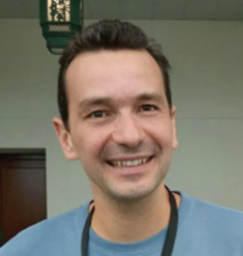The Doctoral Consortium (DC) offers a unique opportunity for students nearing the completion of their doctorate or those who have recently graduated, to engage with experienced researchers in computer vision. Each student will be paired with a senior community member who will act as their mentor, chosen based on the student's preferences or research interests. All students and mentors will attend an in-person DC event during the conference, where students can discuss their ongoing research and career plans with their mentors. Additionally, each student will present a poster, showcasing either their thesis research or a recent paper, to fellow participants and mentors.
See the Call for Doctoral Consortium.
|
Mentee |
Mentee Affiliation |
Mentor |
|
Weihao Xia |
University College London |
Varun Jampani |
|
Paul Gavrikov |
Offenburg University |
Jon Barron |
|
Evin Pınar Örnek |
TU Munich |
Boris Ivanovic |
|
Guénolé Fiche |
CentraleSupélec |
Dimitrios Tzionas |
|
Julia Grabinski |
University of Mannheim |
Elisa Ricci |
|
Tuan-Anh Vu |
The Hong Kong University of Science and Technology |
Leonidas Guibas |
|
Yeji Song |
Seoul National University |
Richard Zhang |
|
Zhiyang Dou |
UNIVERSITY OF PENNSYLVANIA |
Oisin Mac Aodha |
|
Changhoon Kim |
Arizona State University |
Vincent Lepetit |
|
Hyeokjun Kweon |
KAIST |
Gim Hee Lee |
|
Jia-Wei Liu |
National University of Singapore |
Andrea Vedaldi |
|
irit chelly |
Ben Gurion University of the Negev |
Xavier Giro-i-Nieto |
|
Deepti B Hegde |
Johns Hopkins University |
Angjoo Kanazawa |
|
Sayanton V. Dibbo |
Dartmouth College |
Kosta Derpanis |
|
Antonio Alliegro |
Politecnico di Torino |
Christoph Feichtenhofer |
|
Sung-Hoon Yoon |
KAIST |
Sangdoo Yun |
|
Shahaf E Finder |
Ben-Gurion University |
Michael Black |
|
Ginger D Delmas |
NAVER LABS EUROPE |
Lingjie Liu |
|
Ivona Najdenkoska |
University of Amsterdam |
Georgios Pavlakos |
|
Surbhi Mittal |
Indian Institute of Technology, Jodhpur |
Olga Russakovsky |
|
Ishan Rajendrakumar Dave |
University of Central Florida |
Cees G. M. Snoek |
|
Parsa Mirdehghan |
University of Toronto |
Marc Pollefeys |
|
Zhecan Wang |
Columbia University |
Qixing Huang |
|
Seunggeun Chi |
Purdue University |
Hanbyul Joo |
|
Denys Rozumnyi |
ETH Zurich |
Daniel Cremers |
|
Rosario Leonardi |
University of Catania |
Georgia Gkioxari |
|
Mina Ghadimi Atigh |
University of Amsterdam |
Amir Zamir |
|
Jaehui Hwang |
Yonsei University |
Seong Joon Oh |
|
Manasi Muglikar |
University of Zurich |
Kyros Kutulakos |
|
Kai Chen |
The Chinese University of Hong Kong |
Federico Tombari |
|
Zipeng Xu |
University of Trento |
Dima Damen |
|
Camillo Quattrocchi |
University of Catania |
Andrea Tagliasacchi |
|
Mathis Petrovich |
Ecole des Ponts |
Marco Cristani |
|
Rui Gong |
ETH Zurich |
Lamberto Ballan |
Synthesia: From computer vision research to real-world AI avatars
Synthesia is one of Europe's newest billion-euro startups. Its core technology is script-to-video: realistic AI avatars delivernig compelling presentations to the virtual camera. Used by more than 50,000 companies worldwide, including 400 of the Fortune 500, it is computer vision technology that operates in the real world.
Lourdes Agapito and Vittorio Ferrari will talk about the development of this technology from computer vision research papers to real-world product, and about the current and future directions of their research.

